Welcome to the captivating journey of Equatorial Guinea Green Building History, where sustainable construction practices and eco-friendly architecture have played a central role in shaping the country’s architectural landscape.
- Equatorial Guinea has experienced significant economic transformation due to the discovery of oil and gas.
- Infrastructure development, including the construction of a new capital city called Oyala, has been a major focus.
- The construction of Oyala has raised concerns about the clearing of rainforests and its impact on biodiversity.
- The lack of environmental consideration and its effect on indigenous communities have been criticized.
- Efforts to restore historic buildings from the Spanish colonial era are part of tourism promotion and economic diversification initiatives.
Evolution of Green Building in Equatorial Guinea
Over the years, Equatorial Guinea has witnessed a remarkable transformation in its construction practices, embracing renewable materials, prioritizing energy efficiency, and striving to reduce its carbon footprint. With a growing awareness of the environmental impact of traditional construction methods, the country has taken significant steps towards sustainable development.
One key aspect of this evolution is the use of renewable materials in building projects. Equatorial Guinea has recognized the importance of sourcing materials that are environmentally friendly and have a minimal impact on natural resources. By incorporating materials such as bamboo, timber from sustainable forests, and recycled materials, the country has been able to reduce its reliance on non-renewable resources and create structures that are both aesthetically pleasing and environmentally conscious. This shift towards renewable materials not only contributes to the preservation of the environment but also supports the local economy and promotes sustainable industries.
Another significant aspect of the green building evolution in Equatorial Guinea is the focus on energy-efficient buildings. The country has adopted innovative technologies and practices aimed at reducing energy consumption and reliance on non-renewable energy sources. This includes the implementation of energy-efficient design principles, such as proper insulation, natural ventilation, and the use of energy-saving appliances and systems. These measures not only help reduce carbon emissions but also contribute to long-term cost savings for both homeowners and businesses.
The government of Equatorial Guinea has also prioritized efforts to reduce the carbon footprint of its construction industry. By encouraging the use of renewable energy sources, such as solar power, and implementing policies that promote energy-efficient practices, the country has made significant strides in minimizing its impact on the environment. These initiatives not only contribute to global climate change mitigation but also position Equatorial Guinea as a leader in sustainable development within the region.
| Benefits of Green Building in Equatorial Guinea |
| Reduction in energy consumption |
| Preservation of natural resources |
| Cost savings through energy efficiency |
| Promotion of sustainable industries |
Equatorial Guinea’s commitment to green building practices has not only transformed its construction industry but also promotes a sustainable and environmentally conscious future. By embracing renewable materials, prioritizing energy efficiency, and striving to reduce its carbon footprint, the country serves as an example to others in the region and beyond.
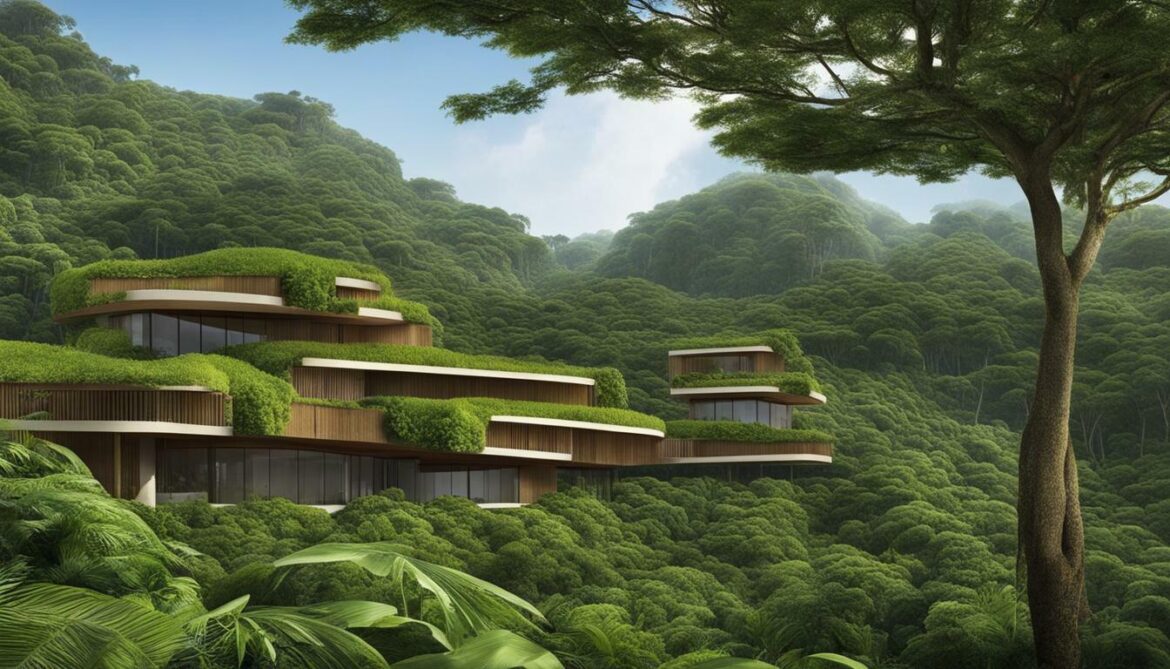
Equatorial Guinea’s commitment to sustainable design principles has paved the way for environmentally conscious construction, creating buildings that harmoniously integrate with the surrounding environment. The country embraces a range of sustainable design principles to minimize its ecological footprint and promote a greener future.
One of the key principles adopted is the use of renewable materials. Equatorial Guinea recognizes the importance of utilizing sustainable resources that can be replenished. Building materials such as bamboo, recycled timber, and locally sourced stone are favored, reducing the reliance on non-renewable resources and minimizing the carbon footprint of construction projects.
- Emphasizing energy efficiency is another crucial aspect of sustainable design in Equatorial Guinea. Buildings are designed to maximize natural lighting and ventilation, reducing the need for artificial lighting and air conditioning. This not only reduces energy consumption but also creates healthier indoor environments for occupants.
- Water conservation is also a top priority. Equatorial Guinea promotes the use of water-efficient fixtures and systems, including rainwater harvesting and wastewater recycling. This helps to minimize water waste and preserve precious resources in a country where water scarcity is a concern.
Equatorial Guinea’s environmentally conscious construction practices extend beyond individual buildings to encompass the entire urban landscape. The country invests in innovative green infrastructure development projects, such as the creation of green spaces, pedestrian-friendly pathways, and cycling infrastructure. These initiatives aim to enhance the quality of life for residents while promoting a sustainable and eco-friendly urban environment.
“Equatorial Guinea’s commitment to sustainable design principles and environmentally conscious construction practices is a testament to their dedication to creating a greener future,” says Alex Johnson, an architect specializing in sustainable design. “By prioritizing renewable materials, energy efficiency, water conservation, and green infrastructure development, Equatorial Guinea is setting a positive example for other nations to follow.”
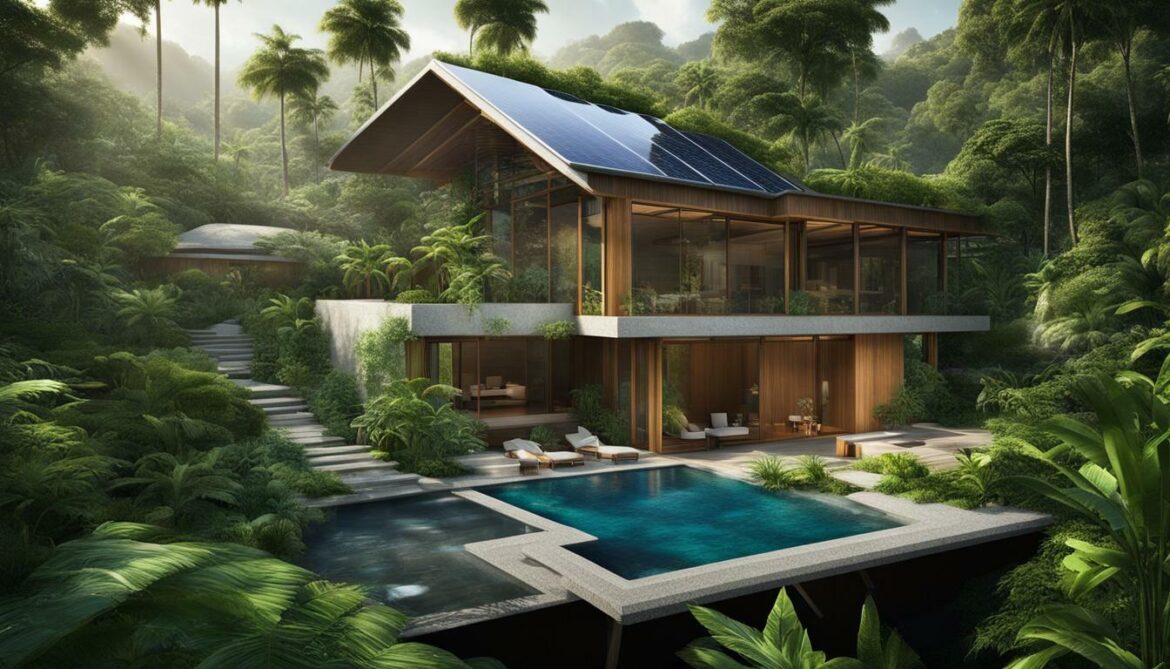
| Key Sustainable Design Principles |
Description |
| Use of Renewable Materials |
Equatorial Guinea employs sustainable building materials that can be replenished, reducing reliance on non-renewable resources. |
| Energy Efficiency |
Buildings are designed to maximize natural lighting and ventilation, minimizing the need for artificial lighting and air conditioning. |
| Water Conservation |
Water-efficient fixtures, rainwater harvesting, and wastewater recycling are encouraged to minimize water waste. |
| Green Infrastructure Development |
Equatorial Guinea invests in the creation of green spaces, pedestrian-friendly pathways, and cycling infrastructure to promote sustainable urban environments. |
Green Infrastructure Development in Equatorial Guinea
Equatorial Guinea has recognized the significance of green infrastructure development, aiming to create sustainable urban environments that prioritize the well-being of its residents and minimize environmental impact. The country’s commitment to green building practices and eco-friendly architecture is evident in its efforts to incorporate green infrastructure into its development plans.
Green infrastructure refers to the integration of natural elements such as parks, gardens, and water features into the built environment. It is designed to enhance the quality of life for residents, promote biodiversity, and mitigate the effects of climate change. Equatorial Guinea understands the importance of incorporating these elements into its urban landscapes, and has taken steps to ensure that green infrastructure development is a key component of its construction projects.
One example of green infrastructure development in Equatorial Guinea is the inclusion of green spaces in the design of the new capital city, Oyala. Despite the environmental concerns raised by the construction process, the government has made efforts to mitigate the impact on biodiversity by replanting trees and preserving natural habitats wherever possible. This shows a commitment to balancing development with environmental preservation.
Equatorial Guinea’s green infrastructure development initiatives are not only focused on urban areas. The country is also investing in renewable energy projects, such as solar and wind farms, to reduce its carbon footprint and promote sustainable energy sources. These projects not only contribute to the country’s green infrastructure goals but also demonstrate its commitment to transitioning to a more environmentally conscious future.
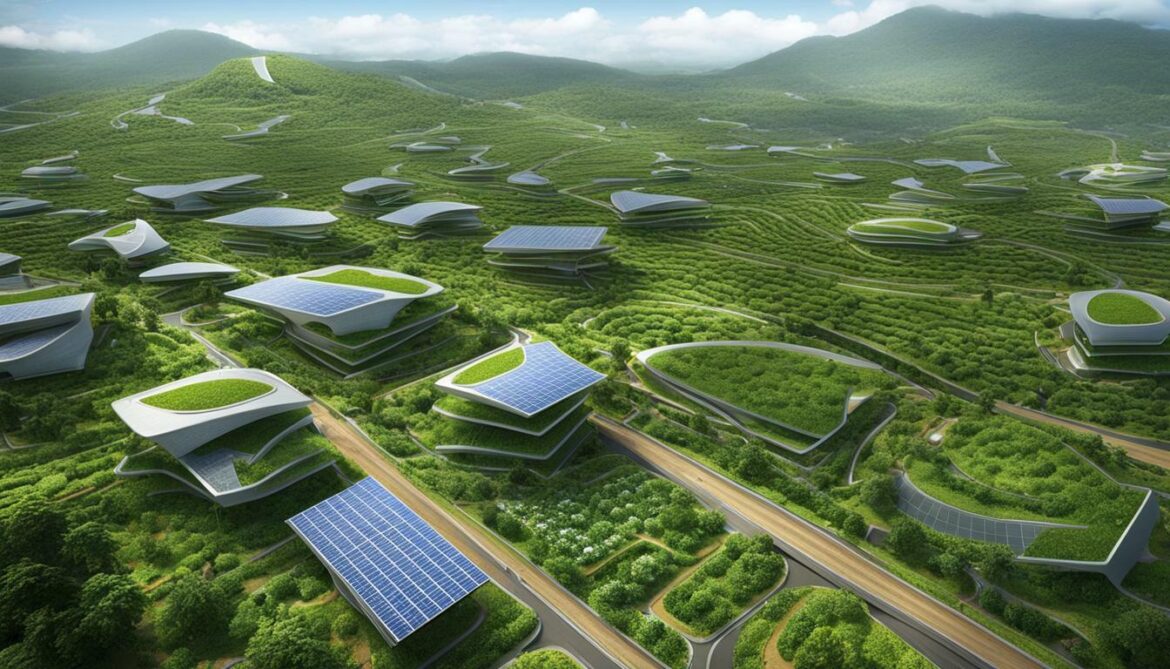
| Benefits of Green Infrastructure Development |
Examples |
| Improvement of air and water quality |
Creation of parks and gardens that act as natural filters for pollutants |
| Enhancement of biodiversity |
Promotion of green corridors and protected habitats for wildlife |
| Climate change mitigation |
Integration of green roofs and walls to regulate temperature and reduce energy consumption |
| Community well-being |
Provision of recreational spaces for exercise and relaxation |
Equatorial Guinea’s commitment to green infrastructure development reflects its understanding of the importance of sustainable urban environments. By integrating natural elements into its cities and investing in renewable energy, the country is taking positive steps towards a greener future.
Environmental Challenges and Criticisms
While Equatorial Guinea has made significant progress in its green building history, it has also faced environmental challenges, particularly concerning the impact on indigenous communities and criticism surrounding the lack of environmental consideration. The country’s rapid economic growth, driven by the oil and gas industry, has led to a boom in infrastructure development, including the construction of the new capital city, Oyala. However, this development has come at a cost to the environment, specifically the clearing of vast hectares of rainforest.
This clearing of rainforests in Equatorial Guinea poses a significant threat to the country’s rich biodiversity. The rainforests are home to numerous unique species of plants and animals, many of which are now at risk of extinction due to habitat loss. Additionally, the displacement of indigenous communities who have relied on these forests for generations has raised concerns about cultural heritage and livelihood disruptions.
Furthermore, the government has faced criticism for not prioritizing environmental considerations in its construction projects. The rapid pace of development has often resulted in inadequate environmental impact assessments and insufficient measures to mitigate the ecological consequences. This lack of foresight and planning has led to irreversible damage to the environment and undermined sustainable development efforts.
In order to address these challenges and criticisms, it is essential for Equatorial Guinea to adopt a more holistic approach to green building. This includes conducting thorough environmental assessments prior to any construction project, involving local communities in decision-making processes, and prioritizing the preservation of natural habitats and indigenous cultures. By integrating sustainability principles into its development plans, Equatorial Guinea can ensure a more environmentally conscious and socially responsible future.
Table: Environmental Challenges and Criticisms
| Challenges |
Criticisms |
| Clearing of rainforests |
Lack of environmental consideration |
| Threat to biodiversity |
Inadequate environmental impact assessments |
| Displacement of indigenous communities |
Insufficient measures to mitigate ecological consequences |

The Transformation of Oyala
The construction of Oyala, Equatorial Guinea’s new capital city, has brought economic growth but not without significant environmental concerns, including the clearing of rainforests and its potential impact on biodiversity. This rapid development has raised questions about the sustainability of Equatorial Guinea’s construction practices and their long-term effects on the country’s natural resources.
As thousands of hectares of rainforest are cleared to make way for new infrastructure, the unique biodiversity of the region is under threat. The dense forests of Equatorial Guinea are home to a wide range of plant and animal species, many of which are found nowhere else on Earth. This loss of habitat not only endangers these species but also disrupts the delicate balance of the local ecosystem.
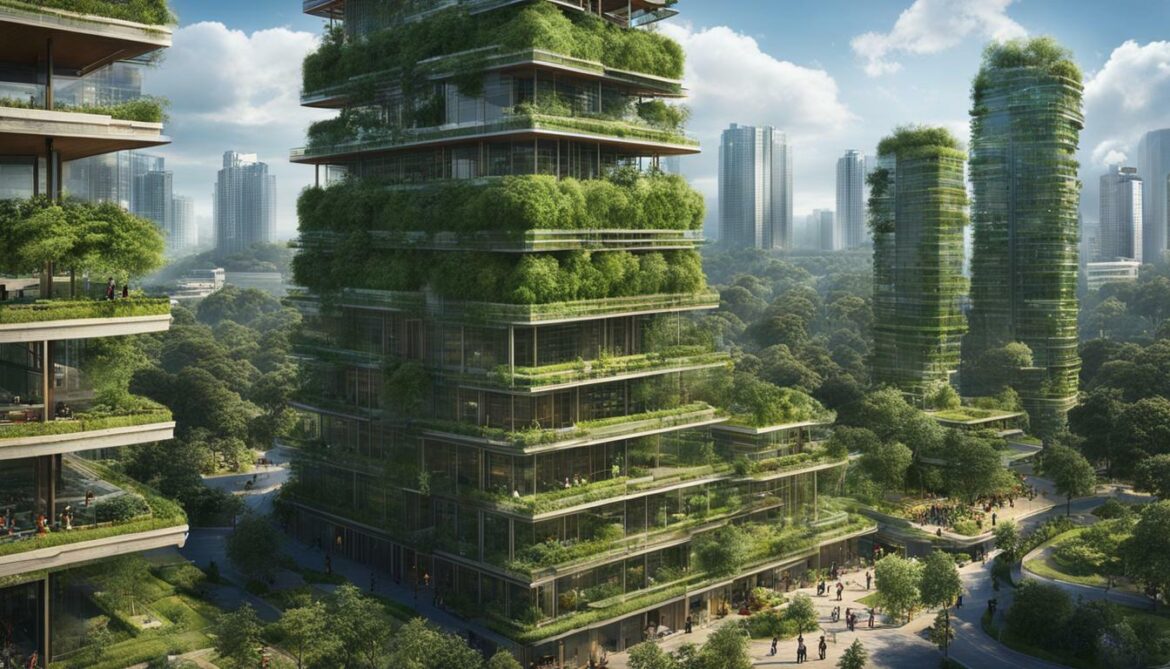
The government’s focus on rapid development has come at a cost to the environment, with indigenous communities being disproportionately affected. Their traditional lands and livelihoods have been disrupted, leading to social and cultural challenges. Critics argue that more consideration should have been given to the potential ecological impact of the construction projects and greater efforts made to involve local communities in the decision-making process.
Efforts are now underway to mitigate the environmental damage caused by the construction of Oyala and other infrastructure projects. The government has pledged to prioritize sustainable development practices, incorporating green building techniques and conservation measures into future projects. However, the scale of the challenge remains significant, and it will require a concerted effort from all stakeholders to ensure the long-term sustainability of Equatorial Guinea’s development.
| Construction of Oyala |
Biodiversity |
Rainforest |
| The rapid development |
The unique biodiversity |
The dense rainforests |
| Environmental concerns |
Endangered species |
Disrupted ecosystem |
| Impact on indigenous communities |
Social and cultural challenges |
Economic diversification |
| Sustainable development efforts |
Green building techniques |
Conservation measures |
Restoration of Historic Buildings
As Equatorial Guinea seeks to promote tourism and diversify its economy, significant focus has been placed on the restoration of historic buildings from the Spanish colonial era, showcasing the country’s rich architectural heritage. These buildings serve as a reminder of Equatorial Guinea’s colonial past and provide visitors with a glimpse into its fascinating history.
The restoration efforts have been meticulous, with skilled artisans and conservation experts working hard to preserve the original characteristics and charm of these structures. From grand cathedrals to quaint colonial houses, each building tells a story of the bygone era and holds immense cultural value for the country.
“The restoration of these historic buildings not only preserves our heritage but also provides opportunities for economic growth through tourism,” says Pablo Mbang Mba, Director of Tourism and Culture in Equatorial Guinea. “We want to showcase the unique blend of Spanish and African influences in our architecture and attract visitors from around the world.”
One of the notable restoration projects is the Santa Isabel Cathedral in Malabo, the capital city of Equatorial Guinea. This magnificent structure, originally built in the early 20th century, has undergone extensive renovation to bring back its former glory. The cathedral’s stunning facade and intricate interior design make it a must-visit attraction for tourists.
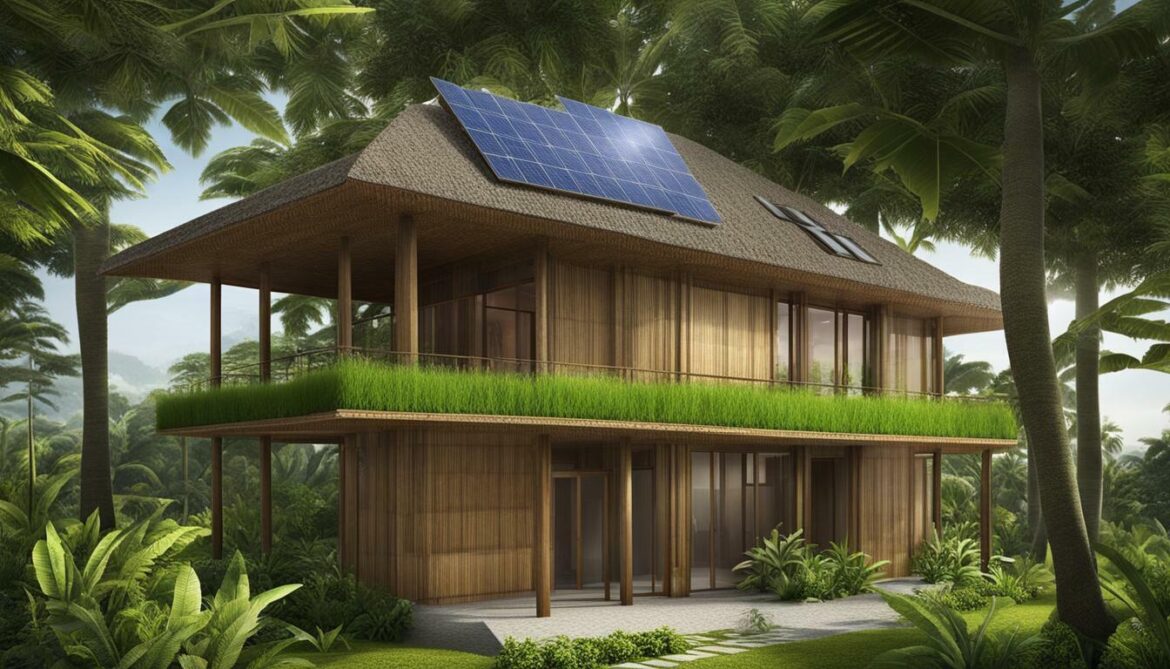
| Building Name |
Location |
Year Built |
| Malabo Government Palace |
Malabo |
1897 |
| Santa Isabel Cathedral |
Malabo |
1916 |
| Bata Central Market |
Bata |
1914 |
| La Casa Verde |
Luba |
1890 |
Conclusion
In conclusion, Equatorial Guinea’s green building history is a testament to the country’s commitment to sustainable construction practices and eco-friendly architecture, showcasing its evolution and the necessity of prioritising environmental considerations in future development projects. The discovery of oil and gas has propelled the country into a period of rapid infrastructure development, with the construction of Oyala, the new capital city, being a prominent example. However, the environmental impact of this development cannot be ignored.
The construction of Oyala has resulted in the clearance of vast hectares of rainforest, posing a significant threat to Equatorial Guinea’s diverse biodiversity. This has raised concerns about the long-term sustainability of the new city and the need for responsible environmental stewardship. Critics have pointed out the lack of sufficient environmental consideration and the detrimental effect on indigenous communities.
Nevertheless, there are positive efforts being made to mitigate the environmental impact and promote sustainable practices. Equatorial Guinea is restoring historic buildings from the Spanish colonial era, not only to promote tourism but also as part of its economic diversification initiatives. This preservation of cultural heritage demonstrates a recognition of the importance of balancing development with the preservation of history and natural resources.
Going forward, Equatorial Guinea must continue to prioritize sustainable design principles, energy efficiency, and the use of renewable materials in construction projects. Learning from the challenges faced in the evolution of green building, the country can strive to minimize its carbon footprint and find innovative solutions for future development. By integrating environmental considerations into its infrastructure plans, Equatorial Guinea can demonstrate its commitment to a greener and more sustainable future.
FAQ
What is Equatorial Guinea’s green building history?
Equatorial Guinea has a history of sustainable construction practices and eco-friendly architecture. The country has undertaken various green building initiatives to promote environmentally conscious construction.
How has green building evolved in Equatorial Guinea?
Green building in Equatorial Guinea has evolved with the use of renewable materials, the development of energy-efficient buildings, and efforts to reduce carbon footprints.
What are the sustainable design principles in Equatorial Guinea?
Equatorial Guinea emphasizes sustainable design principles and environmentally conscious construction practices in its building projects.
What green infrastructure development initiatives have taken place in Equatorial Guinea?
Equatorial Guinea has undertaken green infrastructure development initiatives focused on creating sustainable and environmentally friendly urban spaces.
What are the environmental challenges and criticisms related to Equatorial Guinea’s green building history?
Equatorial Guinea faces environmental challenges, including the impact on indigenous communities and criticisms regarding the lack of environmental consideration in green building practices.
How has the construction of the new capital city, Oyala, transformed Equatorial Guinea?
The construction of Oyala, Equatorial Guinea’s new capital city, has led to concerns about the clearing of rainforests and its impact on biodiversity.
What is being done to restore historic buildings in Equatorial Guinea?
Equatorial Guinea is making efforts to restore historic buildings from the Spanish colonial era as part of its tourism promotion and economic diversification initiatives.
What is the conclusion of Equatorial Guinea’s green building history?
Equatorial Guinea has made significant progress in its green building history, embracing sustainable practices, but it is crucial to continue prioritizing environmental consciousness in construction for the future.
Source Links
























Post comments (0)